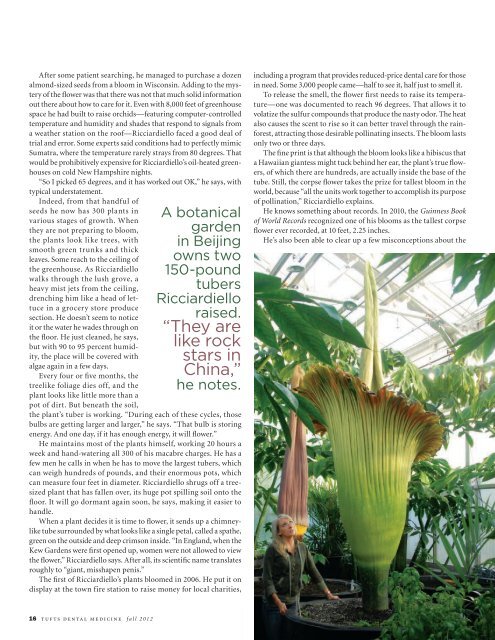Download the latest version - Tufts University School of Dental ...
Download the latest version - Tufts University School of Dental ...
Download the latest version - Tufts University School of Dental ...
You also want an ePaper? Increase the reach of your titles
YUMPU automatically turns print PDFs into web optimized ePapers that Google loves.
After some patient searching, he managed to purchase a dozen<br />
almond-sized seeds from a bloom in Wisconsin. Adding to <strong>the</strong> mystery<br />
<strong>of</strong> <strong>the</strong> flower was that <strong>the</strong>re was not that much solid information<br />
out <strong>the</strong>re about how to care for it. Even with 8,000 feet <strong>of</strong> greenhouse<br />
space he had built to raise orchids—featuring computer-controlled<br />
temperature and humidity and shades that respond to signals from<br />
a wea<strong>the</strong>r station on <strong>the</strong> ro<strong>of</strong>—Ricciardiello faced a good deal <strong>of</strong><br />
trial and error. Some experts said conditions had to perfectly mimic<br />
Sumatra, where <strong>the</strong> temperature rarely strays from 80 degrees. That<br />
would be prohibitively expensive for Ricciardiello’s oil-heated greenhouses<br />
on cold New Hampshire nights.<br />
“So I picked 65 degrees, and it has worked out OK,” he says, with<br />
typical understatement.<br />
Indeed, from that handful <strong>of</strong><br />
seeds he now has 300 plants in<br />
various stages <strong>of</strong> growth. When<br />
<strong>the</strong>y are not preparing to bloom,<br />
<strong>the</strong> plants look like trees, with<br />
smooth green trunks and thick<br />
leaves. Some reach to <strong>the</strong> ceiling <strong>of</strong><br />
<strong>the</strong> greenhouse. As Ricciardiello<br />
walks through <strong>the</strong> lush grove, a<br />
heavy mist jets from <strong>the</strong> ceiling,<br />
drenching him like a head <strong>of</strong> lettuce<br />
in a grocery store produce<br />
section. He doesn’t seem to notice<br />
it or <strong>the</strong> water he wades through on<br />
<strong>the</strong> floor. He just cleaned, he says,<br />
but with 90 to 95 percent humidity,<br />
<strong>the</strong> place will be covered with<br />
algae again in a few days.<br />
Every four or five months, <strong>the</strong><br />
treelike foliage dies <strong>of</strong>f, and <strong>the</strong><br />
plant looks like little more than a<br />
pot <strong>of</strong> dirt. But beneath <strong>the</strong> soil,<br />
<strong>the</strong> plant’s tuber is working. “During each <strong>of</strong> <strong>the</strong>se cycles, those<br />
bulbs are getting larger and larger,” he says. “That bulb is storing<br />
energy. And one day, if it has enough energy, it will flower.”<br />
He maintains most <strong>of</strong> <strong>the</strong> plants himself, working 20 hours a<br />
week and hand-watering all 300 <strong>of</strong> his macabre charges. He has a<br />
few men he calls in when he has to move <strong>the</strong> largest tubers, which<br />
can weigh hundreds <strong>of</strong> pounds, and <strong>the</strong>ir enormous pots, which<br />
can measure four feet in diameter. Ricciardiello shrugs <strong>of</strong>f a treesized<br />
plant that has fallen over, its huge pot spilling soil onto <strong>the</strong><br />
floor. It will go dormant again soon, he says, making it easier to<br />
handle.<br />
When a plant decides it is time to flower, it sends up a chimneylike<br />
tube surrounded by what looks like a single petal, called a spa<strong>the</strong>,<br />
green on <strong>the</strong> outside and deep crimson inside. “In England, when <strong>the</strong><br />
Kew Gardens were first opened up, women were not allowed to view<br />
<strong>the</strong> flower,” Ricciardiello says. After all, its scientific name translates<br />
roughly to “giant, misshapen penis.”<br />
The first <strong>of</strong> Ricciardiello’s plants bloomed in 2006. He put it on<br />
display at <strong>the</strong> town fire station to raise money for local charities,<br />
16 tufts dental medicine fall 2012<br />
A botanical<br />
garden<br />
in beijing<br />
owns two<br />
150-pound<br />
tubers<br />
Ricciardiello<br />
r a i s e d .<br />
“<strong>the</strong>y are<br />
like rock<br />
stars in<br />
China,”<br />
he notes.<br />
including a program that provides reduced-price dental care for those<br />
in need. Some 3,000 people came—half to see it, half just to smell it.<br />
To release <strong>the</strong> smell, <strong>the</strong> flower first needs to raise its temperature—one<br />
was documented to reach 96 degrees. That allows it to<br />
volatize <strong>the</strong> sulfur compounds that produce <strong>the</strong> nasty odor. The heat<br />
also causes <strong>the</strong> scent to rise so it can better travel through <strong>the</strong> rainforest,<br />
attracting those desirable pollinating insects. The bloom lasts<br />
only two or three days.<br />
The fine print is that although <strong>the</strong> bloom looks like a hibiscus that<br />
a Hawaiian giantess might tuck behind her ear, <strong>the</strong> plant’s true flowers,<br />
<strong>of</strong> which <strong>the</strong>re are hundreds, are actually inside <strong>the</strong> base <strong>of</strong> <strong>the</strong><br />
tube. Still, <strong>the</strong> corpse flower takes <strong>the</strong> prize for tallest bloom in <strong>the</strong><br />
world, because “all <strong>the</strong> units work toge<strong>the</strong>r to accomplish its purpose<br />
<strong>of</strong> pollination,” Ricciardiello explains.<br />
He knows something about records. In 2010, <strong>the</strong> Guinness Book<br />
<strong>of</strong> World Records recognized one <strong>of</strong> his blooms as <strong>the</strong> tallest corpse<br />
flower ever recorded, at 10 feet, 2.25 inches.<br />
He’s also been able to clear up a few misconceptions about <strong>the</strong>

















